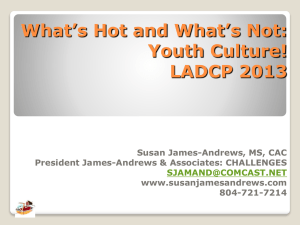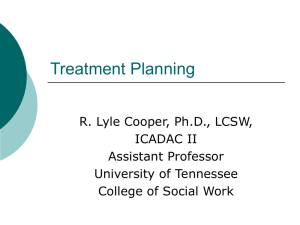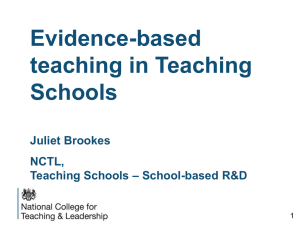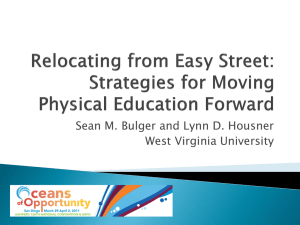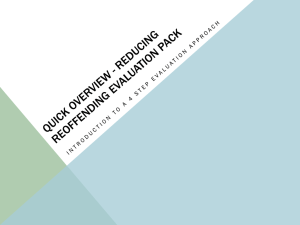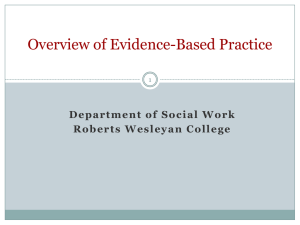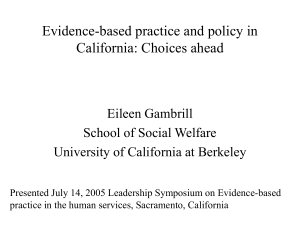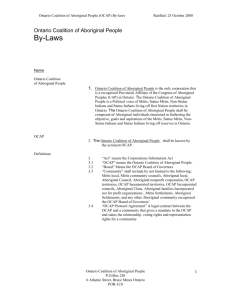This paper describes a case assessment, planning, and evaluation
advertisement
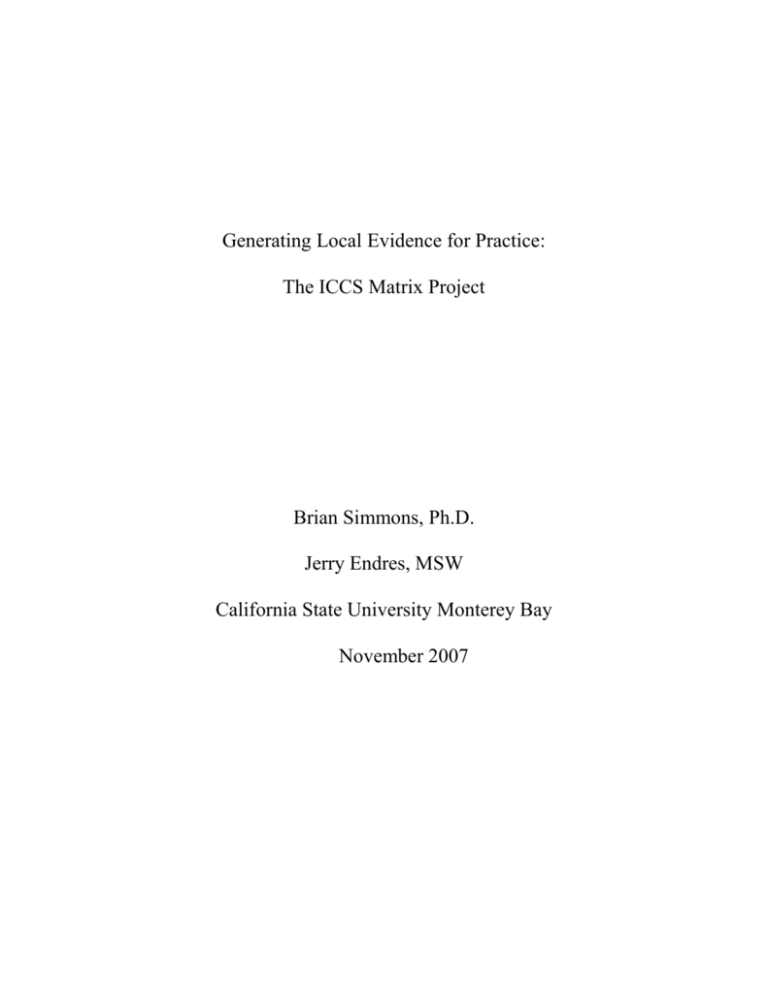
Generating Local Evidence for Practice: The ICCS Matrix Project Brian Simmons, Ph.D. Jerry Endres, MSW California State University Monterey Bay November 2007 “In order to have more evidenced based practice, we need more practice based evidence” Larry W. Green This paper describes a case assessment, planning, and evaluation model currently in use by a number of family service and public sector social service agencies currently involved in a project funded by the California Office of Child Abuse Prevention (OCAP). It does so in the context of the evidence-based practice movement, both providing a means for practitioners to evaluate the effectiveness of their interventions and suggesting the importance of practitioners generating their own body of contextually specific evidence to support their choice of approaches to client intervention. Background and Literature Review Gambrill (1999, 2001) has argued that social work is a profession which posits a broad set of claims to knowledge without providing any evidentiary support for those claims and that, in so doing, social workers fail to honor their ethical commitments to empower and inform clients and to offer competent services. The antidote she proposes (i.e., the way to actually support the profession’s claims to knowledge) is to move from “knowledge” based solely on the authority of the profession to knowledge based on available valid and reliable evidence (Gambrill, 1999). Gambrill and others (see, for example, O’Hare, 2005) draw on the pioneering work of a group of Canadian and Oxford-based physicians (Sackett, Richardson, and Haynes, 1997) who sought to change the way doctors practiced medicine as a means for leading to improved patient care. They were concerned that not only were physicians not making use of current medical 2 research to inform their practice decisions, there was in fact no professional cultural support for doing so and very little technological support for obtaining such research had the desire to do so even been there (Straus, Richardson, Glasziou, & Haynes, 2005). Gambrill would undoubtedly voice those same concerns for the social work profession. The physicians and social workers are not alone in their concerns, as demonstrated by the speed with which this “evidence-based” movement has taken hold and been adopted by a variety of professions. While a number of definitions of evidence-based practice (hereafter, EBP) in the field of social work have been offered, O’Hare’s (2005) is as straightforward as any. He says that EBP is “the planned use of empirically supported assessment and intervention methods combined with the judicious use of monitory and evaluation strategies for the purposes of improving the psychosocial well being of clients.” There are, then, three critical components to EBP: ● conducting qualitative assessments informed by current human behavior research and accompanied by the use of reliable and valid quantitative assessment instruments which can be used for subsequent monitoring and evaluation; ● selecting and implementing interventions that have been shown to be efficacious in controlled outcome research while maintaining some flexibility in actual implementation to accommodate client needs and situational factors; and ● implementing evaluation methods as part of practice at the individual and program level (O’Hare, 2005, p. 6). 3 Both the Oxford physicians (Straus, Richardson, Glasziou, & Haynes, 2005) and the social work scholars (O’Hare, 2005) caution against a mechanized or routinized application of research findings without any sense of the client’s (or patient’s) specific circumstances. Strauss and her colleagues (2005) couch this in terms of “patient values,” by which they mean “the unique preferences, concerns, and expectations each patient brings to a clinical encounter and which must be integrated into clinical decisions if they are to serve the patient” (p.1). The project described in this paper attempts to address some of these core EBP elements. It is this third element of EBP with the Matrix Outcomes Model, the procedural framework described in this paper, is particularly concerned. In that sense, the authors wish to cast this work in the long tradition of social services providers using practice evaluation research to guide their choice of interventions and to make any needed modifications of those interventions (see, for example, Fisher, 1973 and Wood, 1978). But specifically, the Matrix Outcomes Model provides an empirical tool to evaluate practice in the specific context of the identified unique needs of the individual client. The Matrix Outcomes Model currently supports 60 family support agencies and their Child Welfare partners in Butte, Del Norte, Lake, Madera, Orange, Placer, Sacramento, San Francisco, San Joaquin, Santa Barbara, Tehama, Ventura and Yolo Counties in California. This pilot project, funded by the California Department of Social Services, Office of Child Abuse Prevention and led by the Institute for Community Collaborative Studies and Strategies (an OCAP funded technical assistance partner) assist countywide 4 networks to implement the Matrix Outcomes Model. The project supports public/private partnerships to prevent child abuse and neglect. It specifically is designed to assist local Child Welfare and Family Support agencies to implement early response interventions as part of a “differential response” strategy for at-risk families. The technical assistance and training necessary for each network to establish a collaborative set of shared outcome indicators is provided. Customizing the Matrix Outcomes Model is a team building process. Members of a local design team come together as one to select indicators, test for validity and reliability, create an assessment protocol, and agree on case planning practices. Program staff and family/parent participation is essential to the process. The project is divided into five modules: 1) At an orientation meeting, each county network organizes a design team for ongoing collaboration. Their initial activities include the selection of countywide, core indicators from the Matrix Creator website. The website contains close to 600 indicators already in use by Matrix Model user agencies. 2) Localized tests are conducted for editing the tool to the specific service programs and populations through a) client and staff indicator validity with feedback to the design team, b) inter-rater reliability consistency of scoring using a case scenario, and c) field tests with client families. The tool is redesigned after each test for common use across agencies. 3) Codes and procedures for collection and entry of family data are developed by the county design team. ICCS and Strategies provides training for program staff in preferred practices for family assessment and case planning using a family empowerment plan that clarifies family and worker roles to better enable family-directed interventions based on 5 identified strengths and resources. It is through the Matrix summary of the client’s strengths and issues of concern across assessment indicators that interventions are based and developed in concert with the client. The worker develops a plan using the client’s perspective and decisions for case management objectives and activities. Both the client and worker roles are identified to activate the “empowerment plan”. 4) Computer training provides family workers and program managers with an in-agency analysis of outcome data for clients, workers, programs, and the collaborative of participating agencies across the county. 5) The analysis of outcome data from across the 13 thirteen counties is conducted by ICCS using the Matrix Creator database. These training and technical steps are designed in a module format with agency expenses supported with a training stipend from OCAP. Discussion Utilization of the Matrix Outcomes Model, as exemplified by the ICCS/ OCAP Project, provides social workers (and also, in this case, family workers) with an easy-to-use empirical tool that allows the practitioners to test the effectiveness of their interventions We suggest that it has the following strengths: ● Communications among partners has been upgraded into a working partnership building capacity for future collaborations. The Matrix Model is easy to use with shared outcomes across agencies in the same community. As can be seen with the ICCS/OCAP Project, agencies in the same community working with the same families agreeing on the common definitions of outcome variables. ● The Matrix provides a great degree of flexibility. Given that the agencies collaborating on the community’s families are the ones who decide what variables are to 6 be included in the individual models, the models will change from community to community to reflect the geographical and cultural specific needs of the population and the program’s specific questions for outcomes evaluation. ● The process for standardizing the outcome indicators across participating agencies provides for a quasi-reliability and validity not available with other such tools and thus allows cross-agency comparison and analysis of outcome data. ● The project has strengthened family support agencies’ capacity to assess outcomes and build empowerment relationships based on the strengths of families. The agency staff are trained to assess the current family condition using a consistent protocol, and utilization of data to discuss the family strengths and areas of concern and then develop an empowering case (intervention) plan. This plan is designed to use the stable and self-sufficient indicator knowledge and competencies of the family to improve incrisis and at-risk level indicators. Improvement in outcomes may well be positively related to the relationship building and the use of family data facilitated by the family worker. ● Increased accountability and data analysis capability through the use of countywide protocols and the web based data system. The ICCS Matrix Creator database enables the charting of findings for the family, the aggregate data of worker cases, agency program outcomes and is used to improve program practices and ultimately to report to funders, boards and the community. We are also mindful of the following limitation of the Matrix Outcomes Model: 7 ● While the orientation to the Matrix Outcomes Model specifically contains a training to maximize consistency in the application of the indicators by multiple users, site-specific or community-specific indicators lack multiple validation and reliability checks and therefore lack generalizablity beyond their respective jurisdictions. Thus, while we support agencies’ adopting the mindset of generating their own evidence in support of their practice theories and interventions, no claim is made to achieving the kind of statistically confirmed inter-rater reliability and valid measures typically associated with rigorous research studies. The Matrix Outcomes Model specifically sacrifices that level of rigor for the ease of use that is its hallmark. In keeping with the original EBP philosophy, however, it also provides local practitioners with an additional base of evidence with which to modify their practice choices with the specific population with which they are working The evaluation products of projects such as the ICCS/OCAP Project discussed in this paper can certainly be viewed as pilots that invite more statistically rigorous studies that do contribute to the generalizable knowledge of the field. In conclusion, the authors are fully committed to the philosophical movement guiding both practice and policy decision-making in the direction of being more informed by evidence. We applaud practitioners and administrators who add a layer of individual and local practice research to supplement that which is available from the published research so that practice decisions do indeed reflect the unique circumstances of the particular client population. 8 References Fischer, J. (1973). Is casework effective? A review. Social Work, 18, 5-20. Gambrill, E. (1999.). Evidence-based practice: An alternative to authority-based practice. Families in Society: The Journal of Contemporary Human Services, 80, 341-350. Gambrill, E. (2006.). Evidence-based practice and policy: Choices ahead. Research on Social Work Practice, 16, 338-357. Gambrill, E. (2001). Social work: An authority-based profession. Research on Social Work Practice, 11, 166-175. O’Hare, T. (2005). Evidence-based practices for social workers: An interdisciplinary approach. Chicago: Lyceum. Sackett, D.L., Richardson, W.S., & Haynes, R.B. (1997). Evidence-based medicine: How to practice and teach EBM. New York: Churchill Livingstone. Straus, S.E., Richardson, W.S., Glasziou, P., & Haynes, R.B. (2005). Evidence-based medicine: How to practice and teach EBM, 3rd ed. New York: Churchill Livingstone. Wood, K. (1978). Casework effectiveness: A new look at the research evidence. Social Work, 23, 437-457. 9
